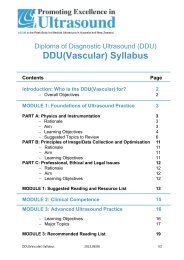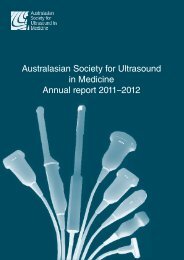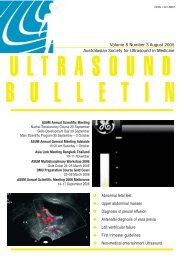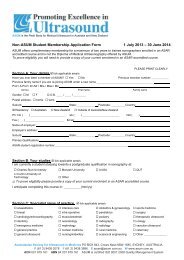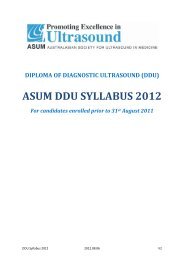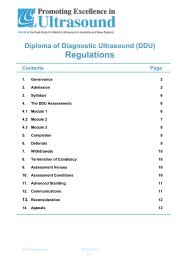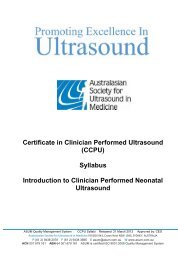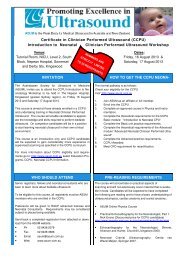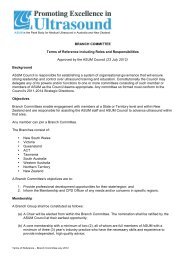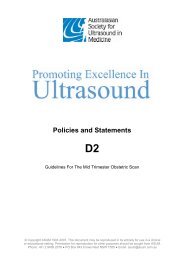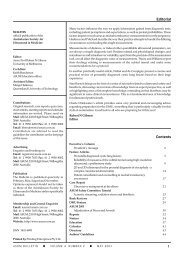Volume 6 Issue 3 - Australasian Society for Ultrasound in Medicine
Volume 6 Issue 3 - Australasian Society for Ultrasound in Medicine
Volume 6 Issue 3 - Australasian Society for Ultrasound in Medicine
- No tags were found...
You also want an ePaper? Increase the reach of your titles
YUMPU automatically turns print PDFs into web optimized ePapers that Google loves.
Live scann<strong>in</strong>g at Annual Scientific Conferences: a new look at ASUM policy<br />
Live scann<strong>in</strong>g at Annual Scientific<br />
Conferences: a new look at ASUM policy<br />
Stanley B Barnett MSc PhD FAIUM<br />
AIUM; ; Chair, , ASUM Safety Committee; Chair, , WFUMB Safety Committee<br />
SUMMARY<br />
This paper reflects the op<strong>in</strong>ions of the author only and is<br />
presented as part of the process of review<strong>in</strong>g exist<strong>in</strong>g ASUM<br />
policy on the use of live models, specifically at annual<br />
scientific conferences, to display ultrasound equipment. I<br />
believe that it is appropriate to adopt a more tolerant and<br />
practical approach to the issue, whilst en<strong>for</strong>c<strong>in</strong>g some<br />
specific conditions to ensure the provision of good safety<br />
marg<strong>in</strong>s.<br />
Analysis of the database on biological effects of diagnostic<br />
ultrasound shows that while the upper level of outputs from<br />
modern ultrasonographic equipment can produce<br />
measurable biological effects <strong>in</strong> laboratory experiments, the<br />
risk of adverse human health effects appears to be low (<strong>for</strong><br />
detail, see accompany<strong>in</strong>g paper <strong>in</strong> this issue of the Bullet<strong>in</strong>).<br />
Whilst there is no conv<strong>in</strong>c<strong>in</strong>g evidence of human harm from<br />
exposure to diagnostic ultrasound, it must be recognised that<br />
data from human studies are <strong>in</strong>adequate. As the develop<strong>in</strong>g<br />
embryo and fetus are sensitive to damage by ultrasound and<br />
heat<strong>in</strong>g and the consequences of perturbed fetal<br />
development would be far greater than <strong>for</strong> adult tissue, it<br />
makes sense to avoid exposure of the embryo or fetus to<br />
ultrasound other than when needed <strong>for</strong> medically <strong>in</strong>dicated<br />
reasons. Clearly, demonstration of equipment at exhibitions<br />
is not a medically <strong>in</strong>dicated situation. It is essential that any<br />
policy statements on the use of live models <strong>for</strong> scann<strong>in</strong>g at<br />
scientific conferences should be based on clear <strong>in</strong>terpretation<br />
of safety issues and not on economic considerations. Given<br />
the above, it is not practical to ban all ultrasonographic<br />
exam<strong>in</strong>ation types. Prudent policy would, rather, avoid any<br />
of the higher risk categories, while allow<strong>in</strong>g live scann<strong>in</strong>g<br />
by other applications under unambiguous practical<br />
guidel<strong>in</strong>es. It is suggested that exist<strong>in</strong>g policy of prohibition<br />
of live scann<strong>in</strong>g by exhibitors be relaxed to allow scann<strong>in</strong>g<br />
under strictly specified limited exposure conditions. Such<br />
prescriptive policy would deny scann<strong>in</strong>g of children and<br />
pregnant women, the use of <strong>in</strong>tracavitary or other <strong>in</strong>vasive<br />
procedures and applications <strong>in</strong>volv<strong>in</strong>g echo-contrast agents.<br />
Acoustic exposure would be limited to equipment displayed<br />
output values of TI




